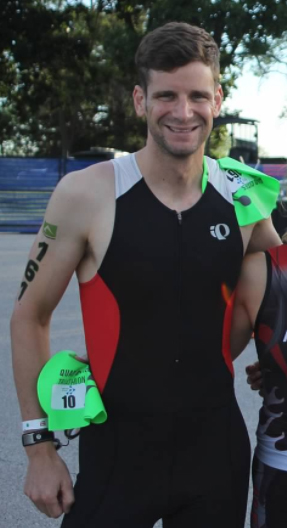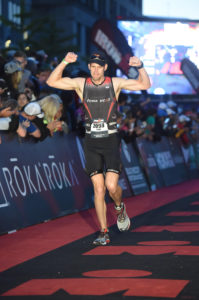My first half-iron that wasn’t: What I learned from my DNF
By Tom R
I signed up for Rev3 70.3, held in Anderson, South Carolina in October of 2014. I picked this race for a few reasons, one of which was that South Carolina was one of two states I hadn’t at that point yet visited. Seriously. And with an October date, I knew I’d have the whole season to train.
When the calendar turned to October, I was ready. I’d put in the work and felt set to go. My car, however, had other ideas. We were going to break up the trip into two days, and the first thing I noticed upon leaving the house on Thursday was a problem with one of my car’s tires. So before we could leave, we had to take the car into the shop and wait 2 hours for them to fix it. Not an auspicious start.
We did the bulk of the driving on Friday, and hit a severe rainstorm in Nashville and horrendous traffic in Atlanta. We were planning on getting into Anderson at around dinnertime on Friday, but didn’t make it there until 10 at night. Fortunately, I had the next day to pick up my packet, visit some local family, scout out the course, and relax.
“Even in a wetsuit, it was quite cold and uncomfortable sitting in the pouring rain, with no idea when the weather would let up.”
The first thing I noticed about the bike course on Saturday was that traffic was not light (the bike course would not be closed to traffic), and the drivers in South Carolina were not exactly bike-friendly. “There’s safety in numbers,” I thought.
On the way back to the hotel after scouting the course, we sat in a traffic jam for what turned out to be an accident where a car had hit a motorcyclist. From the looks of it, the motorcyclist had probably gotten hurt fairly badly. I admit, these things were all starting to play with my mindset.
Dawn broke on Sunday, and it was time to go—except it wasn’t. Rain started right about the time I got to the transition area to get my gear ready, and continued on and off throughout the setup time. And then, just as the swim was about to get underway, the thunder cracked, the skies opened, and the downpour began.
With an ongoing thunderstorm, we waited. And waited. And waited some more. Even in a wetsuit, it was quite cold and uncomfortable sitting in the pouring rain, with no idea when the weather would let up.
Finally, after an hour or so, a window opened up, and the decision was made to have the half-iron racers swim the Olympic course, so that all the swimmers could be out of the water as quickly as possible. “Well, I guess I’ll be doing a 70.0 instead of a 70.3, but that’s basically a rounding error…”
The swim went reasonably well for me—I was toward the front of my wave when I got out of the water, and I hopped on my bike and set off.
The first 10 miles of the bike were fairly uneventful. I found a nice rhythm and rode somewhat conservatively, as the course was hilly and winding and the roads were slick.
And then everything went to hell, as the skies opened up again. The rain came down in sheets. You know how sometimes when you’re driving on the highway and the rain comes down so hard that you have to pull over to the side of the road because you can’t see anything? It was that kind of rain. For miles it poured. And the cars zipped by, splashing water on me as they went. And I was freezing and shivering. The longer the rain went on, the more afraid I got.
 Riding in the rain is one thing. Racing is another.
Riding in the rain is one thing. Racing is another.
The end for me came at about mile 30, riding down a long, steady hill, with the rain pouring and my vision limited. Feeling a bit out of control, I feathered my brakes to slow down a bit, and…nothing. Almost no breaking power. Suddenly, visions of my broken body lying in a ditch somewhere in the deep South entered my brain. I was starting to go into full-on panic mode.
Gradually, I managed to get myself slowed down, while wondering how the heck I was ever going to get through this. And then I saw flashing lights approaching me. “Someone must have crashed and gotten hurt” was my first thought. But then it occurred to me that the police car (I could finally tell that that’s what it was) wasn’t driving fast enough for that. “They must be closing the course and cancelling the race” was my next thought.
At that point, I had completely mentally checked out. I flagged down the officer, figuring I’d ask if the race had been cancelled.
As he passed and asked if he could help me, I realized that the race was still very much on—there was no cancellation. But my race was cancelled, because at that point, I felt afraid and cold and wet and, more to the point, finished.
I spent the next half hour sitting inside a (thankfully warm) police car, chatting with the officer and waiting for a race official to pick me up. And in that time, I saw bikes go by. Bike after bike after bike. And that is when the regret began to kick in. I realized that everyone else was dealing with the same conditions as I, but they kept going, where I quit. And of course in a last bit of poetic justice, about 30 minutes after I’d quit, the rain let up to nothing more than a light drizzle the rest of the day.
I gathered my things from transition and bolted from South Carolina as soon as we could—I wanted nothing more to do with that race. I got a Did Not Finish (DNF) as my just reward.

In the days after the race, as clear-headedness began to reestablish itself, I finally was able to take stock of what went wrong.
I didn’t DNF because I wasn’t physically fit enough. No, I was more than sufficiently trained to cover the distance. I DNF’d because I wasn’t mentally fit enough. This was the moment that I learned that triathlon is as much a mental sport as a physical one.
Was I uncomfortable? Yes. Was I afraid? Yes. Did either of those things require that I stop and quit? No. I was so focused on racing that I forgot all about performing. I was so inflexible that it never even occurred to me to slow down, be cautious, throw my time goals out the window, and just finish the damned race!
USA Triathlon keeps track of every athlete’s race performances. Every time I look mine up, that DNF stares back at me. For a while, it used to make me angry and embarrassed—an ongoing reminder of a lapse in mental toughness.
But now, after a few years have passed, I’ve finally made my peace with my DNF, because, in the long run, it made me a stronger athlete. I committed myself to learning my lessons from that race—chiefly, about being able to take what the race throws at me and adapt to it. I have a mantra now—Just cross that line!
I was finally able to get the half-iron monkey off my back the following spring, and finish my first full Ironman in 2017. And that mantra has gotten me through some incredibly challenging races in some pretty extreme conditions. I know I’m a better racer because of it.
We sometimes need failure to achieve greater success. That DNF is part of who I was, and is part of who I am, as a racer and a person. I own it.







